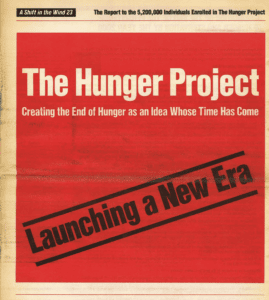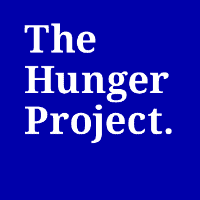Creating a world without hunger.
The Hunger Project Launches New Vision and Mission Statements
This is an exciting time here at The Hunger Project. Vision and Mission Statements are more than a collection of words; they are a reflection of our core values and shared purpose as a global movement. These statements encapsulate the essence of what we stand for and the impact we can create in the world.
Over the last two years, as part of our Strategic Framework process, we have engaged our entire global team in assessing the state of world hunger and identifying what’s missing from the mission to create a world without hunger, once and for all. Humanity has created a global system that allows hunger to persist. Hunger is a reflection of the way we relate to one another. It is a byproduct of injustice. It is clear we need a new level of cooperation and collaboration to confront and deal with the complexity of the issues we face today.
We believe we need a new opening, a new recognition of what is now possible. And so, we have created a new Vision and Mission for our work:
Our vision is a world without hunger.
Our mission is to facilitate individual and collective action to transform the systems of inequity that create hunger and cause it to persist.
Since our founding in 1977, the world has made significant progress in many areas, like maternal and child mortality, public health, and nutrition. From 2005 to 2018, the number of undernourished people dropped by more than 200 million while the population continued to rise. But today we face the stark reality that, after decades of progress in reducing hunger, the trend has reversed. Hunger has been getting worse due to the effects of climate change, conflict, global inequality and the COVID-19 pandemic, and we are now at higher numbers than we were in 2005, with 828 million people undernourished — without sufficient food to lead a healthy, productive life.
Moreover, the gender gap in food insecurity between women and men is widening – women and girls continue to bear the brunt of hunger. This is all despite our effective work (and the work of many others) in communities around the world, where people are thriving and creating better lives for themselves and their families.
Our new Vision and Mission Statements create a radically different future — one that belongs to everyone, where hunger is not created in the first place, where hunger is no longer tolerated. It is a future of peace, where humanity lives in harmony with our natural environment, and where each and every human being is recognized, valued, included and belongs.
What do we mean by…
Systems of Inequity
When we talk of systems of inequity, we are talking about the underlying root causes that give rise to hunger. Hunger is a reflection of the way we relate to one another. It is a byproduct of injustice and unfairness. There’s enough food on the planet and yet, society has been organized to have winners and losers, where not all people have the opportunity to meet their basic needs. Girls are routinely fed less nutritious food than their brothers, and women are systematically denied access to the resources they need to lead healthy and productive lives.
We need to come to grips with the fact that the persistence of hunger is built into our global system. Hunger is the equity challenge of our time. There is a growing recognition of the need for systems-based approaches, which look at how the whole functions and how the elements interrelate. And how such systems intersect with one another. Some examples include:
- Gender Inequality
- Inequitable Economic Systems
- Inequitable Food Systems
- Racism
- Caste Systems
- The relationship between people and their environment
- Inequitable access to healthcare, education, technology, human rights
The launch of these statements provides a new lens and an opportunity for us in The Hunger Project to evolve our ways of working, with new programs, new areas of thought leadership, and new opportunities for active participation. This is only the beginning!
We invite your active participation as we launch this next era for The Hunger Project – together.
The History of Our Engagement with the Issue of World Hunger
Hunger became a global issue after WWII. During that time, hunger was mostly referred to as famine. Many organizations that we know now were founded at that time. The conventional understanding and belief was that hunger was inevitable, and that people living in the conditions of hunger were helpless, hopeless victims. Consistent with that understanding and belief, the best the world could do was to eliminate suffering. The response – therefore – was that food relief was the program.
 When The Hunger Project was launched in 1977, we identified the distinction between famine and starvation and the hidden, chronic hunger affecting millions more people – especially women and children. Our movement challenged the prevailing understanding and belief that hunger was inevitable and that people living in the conditions of hunger were helpless, hopeless victims. It declared that the persistence of hunger could end. We identified that what was missing was not food – but the opportunity for people living in the conditions of hunger to grow their own food and end their own hunger. And so, we pioneered methodologies to empower women and men to end their own hunger in every region of the world where hunger persisted.
When The Hunger Project was launched in 1977, we identified the distinction between famine and starvation and the hidden, chronic hunger affecting millions more people – especially women and children. Our movement challenged the prevailing understanding and belief that hunger was inevitable and that people living in the conditions of hunger were helpless, hopeless victims. It declared that the persistence of hunger could end. We identified that what was missing was not food – but the opportunity for people living in the conditions of hunger to grow their own food and end their own hunger. And so, we pioneered methodologies to empower women and men to end their own hunger in every region of the world where hunger persisted.
Rather than simply being another relief organization, The Hunger Project was created as a strategic organization. Over the years, we have reinvented ourselves time and again to meet each challenge along the path of ending hunger.
Image above: Ethiopia, 2019; Photo for The Hunger Project by Johannes Odé

